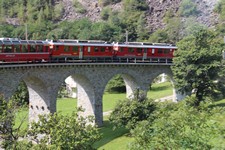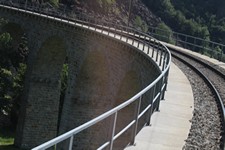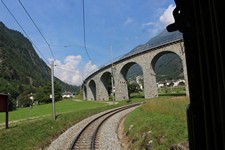
Rail Tour Through the Alps
(Note: Clicking on any image in this travelogue will bring up a full screen version of the image.)
Sunday, September 4
The Bernina Pass Express: St. Moritz to Tirano, Italy and back
Another day of travel solely for the sake of the journey. Remember the old transatlantic cruise ship slogan, "Getting there is half the fun"? In this case it was 90% of the fun, as Tirano is not what I would call a destination unto itself. Oh, it's nice enough, but the main reason to take the trip was the spectacular scenery on the way. So again, I'll let the pictures do most of the talking..
Scenes from the Bernina Pass Express
The rail trip was on the Bernina Pass Express from St. Moritz to Tirano, Italy. We'd spend a couple of hours in Tirano, and then return by coach to St. Moritz. On the way back, we would have the option to take a cable car to the top of Mt. Diavolezza, one of the highest peaks in the area. The Bernina Pass Express is yet another of the world-class scenic rail routes in Switzerland. This is not a dedicated tourist train, but rather part of the regular passenger transport network of the Swiss rail system. However, it certainly is congnizant of the tourist trade, as evidenced by the informative and multi-lingual brochure provided at each seat, from which I have gleaned some of the statistics I offer here, as well as the map at the top of this page. It crests the pass at 7,391 feet of altitude, and descends to 429 feet at Tirano. Along the route is the Circular Viaduct (or as it should be more accurately named, the Helical Viaduct) by means of which it changes altitude by about 25 feet while still maintaining a maximum grade of 7%. Even so, that grade and the 230 foot radius of the curve are both pretty severe for commercial railroads.
We left St. Moritz and started the climb to the crest at Ospizio Bernina. Along the way we had some mighty impressive views of glaciers (Photo #3), rivers (Photo #4), and waterfalls. We stopped for about 15 minutes at the Alp Grum station (Photo #6) just past the peak, and got the chance to view some impressive vistas (Photo #5). I got out to stretch my legs and ogle. When we resumed, I realized that we were in the rearmost car of the train, and there was an unobstructed view out the window in the rear door. So I spent the rest of the trip standing in the little vestibule at the back shooting pictures out the windows of the rear and both side doors.
We started our descent (Photo #7). There was a dam and hydroelectric station, with the power station built in 1923 disguised to look like a castle (Not evident in Photo #9). The switchbacks shown on the map give some idea of how steep the terrain was, and the right-of-way did some pretty serious twists and turns to negotiate it. The downhill side of the mountain also marked a change from the German-speaking portion of Switzerland to the Italian region. Shortly before arriving in Tirano, we reached the picturesque Circular Viaduct.
More accurately it should be called the "Helical Viaduct". This feature like spiral tunnels through the mountain elsewhere in Switzerland and Canada, permits the right of way to change altitude in a short linear space, while maintaining a reasonable shallow grade. Even so, the grade of 7% and the curve radius of 360 feet are still rather severe, and cannot be negotiated by long and heavy freight trains. As a comparison, when we took our previous rail trip through the Canadian Rockies in 2012, we learned that the original specs on the CPR route in the 1880s called for a maximum grade of 2.5%. And when economic constraints forced a 3.5% grade down the Kicking Horse Pass, it was the cause of countless runaway trains and derailments until they remediated the situation a quarter century later with two spiral tunnels.
Circular Viaduct as photographed from the train itself
 13. A few seconds after Photo 12 |
 14. Circular Viaduct viewed out the rear window of the last car. |
 15. Leaving the Circular Viaduct looking out the rear window of the last car. |
Our destination of Tirano was just on the Italian side of the border. Crossing international borders within the European Union isn't quite as inconsequential as crossing state borders in the US, but it's close. We were informed that while we were required to present our passports if asked, but chances were we wouldn't be asked. And we weren't. But there were still noticeable differences . The signs were all in Italian, and, of course, Italian was the default first language spoken. And the obsessive neatness and order that permeates all of Switzerland was relaxed to some degree. But English (and probably German and French and even Romany) were commonly known to one degree or another by the populace, and I had no difficulties in getting around.
Tirano and back
We had a couple of hours to spend in town to eat and sightsee. It was sunny and hot, and a perfect day to be on vacation in Italy. In a town square just by the railroad station, I found a restaurant where I could get a nice ham and cheese sandwich, and leave my camera battery and its charger to get charged up while we wandered. On a disused siding of the station sat a decrepit and forlorn wreck of an old steam engine, probably dating from the 30s or 40s. I wondered about its story, but never found out. We poked around town for a bit, and then wandered off looking for a bit of quiet. We found it in the form of a public park, completely fenced around, but with an unlocked gate. We were surprised to find it completely deserted on a Sunday afternoon, but didn't complain. Jenny found a table to write some post cards, and I stretched out on the grass with my head on my backpack, and copped a few z's.
We got back to the town square well in time to board the bus, and head back to St. Moritz. We crossed the border with a perfunctory examination of the roster and a wave by Customs official. The road and the railway pretty much followed the same route, which was undoubtedly a function of the straightest and levelest terrain between the two cities. We stopped once at a convenient overlook, and noted a small flock of sheep meandering about the road. They were obviously domestic sheep, not wild, but we saw no herdsman to tend them. They seemed to know where they were going, and eventually departed over the rocky terrain to wherever they called home.
I was feeling a little tired, and dozed on and off on the trip back, and was therefore a little surprised when the bus pulled into a parking lot at a small rail station along the way. It seems that there was a side trip scheduled there on a cable car to the top of Mt. Diavolezza with some stunning views. I was a bit confused, because I was under the impression that that ride was to originate in St. Moritz. I was in shorts and had not packed a jacket or sweater, which would be sure to be needed at the top of the mountain. I decided to pass on the cable car ride, but Jenny opted in. So I and a couple of others in the group decided to take the train back to St. Moritz, rather than wait around on the bus for the rest to go up the mountain and back. Jan had a handful of train tickets available for that eventuality.
We took the first train north, boarded an almost empty car, and were a little surprised at the accommodations. The seats were leather, and more comfortable than those in the train we had taken south to Tirano. We found out why when the Conductor came to scan our tickets, and discovered we had chosen a first class car, identified only by a discrete number 1 on a sign on the car's end wall. Chagrined, we shuffled into the next car. In St. Moritz, we climbed the mountain to the general neighborhood of the hotel on a very long escalator. I went back to our room and caught up on correspondence and sleep.
There was another group dinner at a restaurant down by the lake, which we reached via the coach. Jenny had learned of a classical piano concert conveniently close to the restaurant. I decided to hit the rack early and skip the concert. She hiked up the hill and tiptoed in when the concert was over.